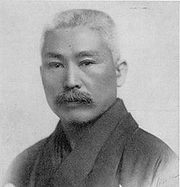
Uchida Ryu Tanjojutsu
Encyclopedia
, also known as Sutekki-Jutsu, is a Japanese martial arts school of tanjojutsu, originally devised by Shinto Muso-ryu
practicitioner Uchida Ryogoro
(1837-1921) as a way to utilize the western-style walking stick into a weapon of self-defence. The tanjo is not to be confused with the pre-meji era short stick hanbo
.
 After the Meiji Restoration
After the Meiji Restoration
in 1869, which would herald the Meiji Era, Japan
took a giant leap from the old feudal system into a more modern western society. The samurai-caste was disestablished and everything western were brought into Japan as a way to modernize both its society and economy. This included the construction of railroads, reforming the military based on the Prussian
system and building new facilities for modern communication and modernising and expanding the domestic industry. It would also bring along western clothing with European clothes as a popular new choice of wardrobe.
Among the things that were imported, the western style walking stick was one of them, and it quickly became a very popular item in Japan, especially for former samurai
who were not allowed to wear swords anymore as a sign of their high status and other high-ranking individuals.
In 1885, Uchida Ryogoro, who was a student of Shinto Muso-ryu
(jodo), devised a new set of self-defence techniques for the tanjo drawn primarily from existing jodo techniques. He did this as a way of popularizing jodo. From the techniques originally created by Uchida Ryogoro a set of 12 kata were put together, with the assistance of his son Uchida Ryohei, and organized into a system which was named Uchida-ryū Tanjōjutsu.

This system is today fully integrated into the Shinto Muso-ryu (jodo) organisation, although some of the techniques and the general handling of the tanjo has been modified over the years.
Shinto Muso-ryu
, most commonly known by its practice of jōdō, is a traditional school of the Japanese martial art of jōjutsu, or the art of wielding the short staff . The technical purpose of the art is to learn how to defeat a swordsman in combat using the jō, with an emphasis on proper combative distance,...
practicitioner Uchida Ryogoro
Uchida Ryogoro
Uchida Ryōgorō Shigeyoshi , , was a Japanese jojutsu practitioner, ranked menkyo in the Japanese martial art of Shintō Musō-ryū...
(1837-1921) as a way to utilize the western-style walking stick into a weapon of self-defence. The tanjo is not to be confused with the pre-meji era short stick hanbo
Hanbo
The hanbō is a staff used in martial arts. Traditionally, the hanbō was approximately three shaku or about long, half the length of the usual staff, the rokushakubō . Diameter was...
.
History

Meiji Restoration
The , also known as the Meiji Ishin, Revolution, Reform or Renewal, was a chain of events that restored imperial rule to Japan in 1868...
in 1869, which would herald the Meiji Era, Japan
Japan
Japan is an island nation in East Asia. Located in the Pacific Ocean, it lies to the east of the Sea of Japan, China, North Korea, South Korea and Russia, stretching from the Sea of Okhotsk in the north to the East China Sea and Taiwan in the south...
took a giant leap from the old feudal system into a more modern western society. The samurai-caste was disestablished and everything western were brought into Japan as a way to modernize both its society and economy. This included the construction of railroads, reforming the military based on the Prussian
Kingdom of Prussia
The Kingdom of Prussia was a German kingdom from 1701 to 1918. Until the defeat of Germany in World War I, it comprised almost two-thirds of the area of the German Empire...
system and building new facilities for modern communication and modernising and expanding the domestic industry. It would also bring along western clothing with European clothes as a popular new choice of wardrobe.
Among the things that were imported, the western style walking stick was one of them, and it quickly became a very popular item in Japan, especially for former samurai
Samurai
is the term for the military nobility of pre-industrial Japan. According to translator William Scott Wilson: "In Chinese, the character 侍 was originally a verb meaning to wait upon or accompany a person in the upper ranks of society, and this is also true of the original term in Japanese, saburau...
who were not allowed to wear swords anymore as a sign of their high status and other high-ranking individuals.
In 1885, Uchida Ryogoro, who was a student of Shinto Muso-ryu
Shinto Muso-ryu
, most commonly known by its practice of jōdō, is a traditional school of the Japanese martial art of jōjutsu, or the art of wielding the short staff . The technical purpose of the art is to learn how to defeat a swordsman in combat using the jō, with an emphasis on proper combative distance,...
(jodo), devised a new set of self-defence techniques for the tanjo drawn primarily from existing jodo techniques. He did this as a way of popularizing jodo. From the techniques originally created by Uchida Ryogoro a set of 12 kata were put together, with the assistance of his son Uchida Ryohei, and organized into a system which was named Uchida-ryū Tanjōjutsu.
Tanjō methods

List of the modern Uchida-ryū Tanjō forms
The modern Uchida-ryū Tanjōjutsu comprises 12 forms.- 1. Kote Uchi (Sa)
- 2. Kote Uchi (Yu)
- 3. Sutemi
- 4. Kuri tsuke
- 5. Ushiro zue
- 6. Suigetsu (Sa)
- 7. Suigetsu (Yu)
- 8. Shamen (Sa)
- 9. Shamen (Yu)
- 10. Kobushi kudaki
- 11. Sune kudaki
- 12. Irimi
This system is today fully integrated into the Shinto Muso-ryu (jodo) organisation, although some of the techniques and the general handling of the tanjo has been modified over the years.

